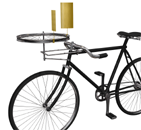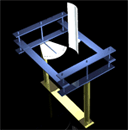 Experiments with the bicycle balance in 1901 convinced the Wright Brothers that they had been using the wrong value for one of the key constants in their calculations. They had based their designs on tables for the coefficient of lift derived from work by the pioneering German aviatior Lilienthal, but now they realised that these tables were wrong. The data from Lilienthal's experiments had been correct but it had later been reinterpreted and published using calculations that assumed a value for Smeaton's coefficient that was too high.
Experiments with the bicycle balance in 1901 convinced the Wright Brothers that they had been using the wrong value for one of the key constants in their calculations. They had based their designs on tables for the coefficient of lift derived from work by the pioneering German aviatior Lilienthal, but now they realised that these tables were wrong. The data from Lilienthal's experiments had been correct but it had later been reinterpreted and published using calculations that assumed a value for Smeaton's coefficient that was too high.
 The design of the lift balance allowed the Wrights to measure the lift coefficient directly. By making a sequence of readjustments to the balance they were able to factor out the drag force of the model wing. Their results were independent of both the Smeaton's coefficient and the air flow velocity, a great advance on previous scientific experiments.
The design of the lift balance allowed the Wrights to measure the lift coefficient directly. By making a sequence of readjustments to the balance they were able to factor out the drag force of the model wing. Their results were independent of both the Smeaton's coefficient and the air flow velocity, a great advance on previous scientific experiments.
 Now that they could measure the lift coefficient, the Wrights designed the drift balance to directly measure the drag to lift ratio. This allowed them to calculate the drag coefficient of their model aerofoils. The Wright Brothers were able to develop a much better understanding of how the shape of a wing determined its aerodynamic properties than anyone before them, and this led to the improved performance of their planes after 1902.
Now that they could measure the lift coefficient, the Wrights designed the drift balance to directly measure the drag to lift ratio. This allowed them to calculate the drag coefficient of their model aerofoils. The Wright Brothers were able to develop a much better understanding of how the shape of a wing determined its aerodynamic properties than anyone before them, and this led to the improved performance of their planes after 1902.
